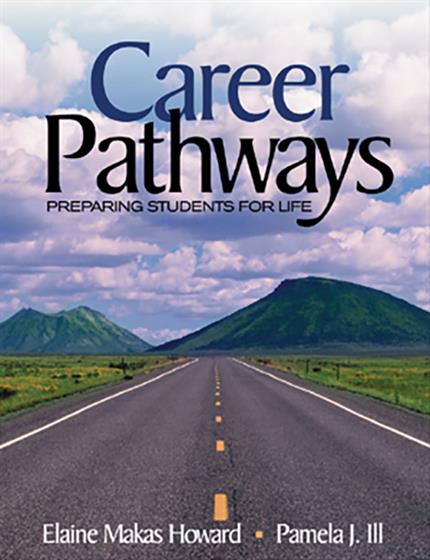Introduction: Student Centered High Schools
Acknowledgements
About the Authors
Dedication
Chapter 1. The What and Why of Career Pathways
The Beginning: A Student Scenario
What is a Pathways High School?
Why Pathways?
Two Closing Scenarios
In Review
Chapter 2. The Collaborative Career Pathways Model
Introduction: A Student Scenario
Model Structure - The Three Pillars
Implementing the Three Pillars
Community Vertical Process
Horizontally Integrating the Pillars
Putting it all Together: The Complete Implementation Chart
Students as the Center of Learning
Pathways and Citizenship
Pathway Myths
Conclusion
In Review
Chapter 3. Steps to Implementing the Model
Introduction: A Community Scenario
Part I. Three Steps to Successful Change - A Process Model
Part II. A Timeline for Implementation
Part III. Funding
Conclusion
In Review
Part I. Building a Foundation
Chapter 4: District Vision and School Leadership: The Pathways Foundation
Intro: An American Scenario
Vision, Mission, Goals and Values
Presenting a Solid Example
A Common Experience
A Common Process
Vision Process Chart
In Review
Chapter 5. Comprehensive Guidance to Prepare and Assist Pathway Students
Scenario
The Importance of Comprehensive Guidance
Career Pathways and Traditional High Schools Guidance Programs
Pathways Comprehensive Guidance and National Counseling Standards
Scheduling in a Career Pathways High School
Educational Development Plans and Portfolios
Student Testing and Data Collection
Creating an Avenue for Pathways Changes and Flexibility
Conclusion
In Review
Chapter 6. Curriculum in a Career Pathways High School: A Rationale for Standards, Mapping and Integration
Introduction: A Curriculum Scenario
The Importance of Curriculum in a Collaborative Career Pathways High School
What is Curriculum?
Integrating Technology
Curriculum Quiz
In Review
Part II. School Structure
Chapter 7. Focus Classes for Each Level of Career Pathways
Scenario
What is a pathways class and why do we have them?
Focus Class Key Concepts and Placement
What Does Each Pathway Class Look Like?
Freshman Explorations: The Cornerstone
Sophomore Selections: The Great Balancing Act
Junior Judgments: The Stepping Stone
Senior Transitions: Moving Forward
How are Focus Classes Delivered?
Curriculum Placement of Focus Classes
Pathway Change Process
The Long-term Results of Focus Class Work
In Review
Chapter 8. Scheduling in a Collaborative Career Pathways High School
Intro - Scenario
The Need to Address Scheduling
Major Types of Scheduling and Career Pathway High Schools
An Ideal Collaborative Career Pathways Schedule
Schedules and Teaching Styles and Professional Development
Creating a Schedule that is Right for Your School
Conclusion
In Review
Part III. Classroom Processes
Chapter 9. Freshman Explorations: The Cornerstone of Pathways Instruction
A Student Scenario
The Important Connections
Freshman Explorations: The Curriculum
In Review
Chapter 10. Pathway Classes Grades 10-12: Sophomore Selections, Junior Judgments and Senior Transitions
Scenario
The Great Scaffold
Sophomore Selections
Junior Judgments
Senior Transitions
The Scaffold Works
In Review
Chapter 11. Core and Elective Teachers as Support for the Career Pathways Instructional Process
Scenario
Gaining Support of the Entire Faculty
Core and Elective Teachers as Part of the Team
Staff Inclusion
Communication in a Pathways High School
Continuous Staff Development and In-Servicing
Teaming and Collaboration
Career Technology & Academy Teachers versus Collaborative Pathway Teachers
Working with the Core Teachers
Working with the Elective Teachers
How Pathway Teachers Differ From Traditional Classroom Teachers
In Review
Part IV. Culture, Community, and Technology
Chapter 12. Public Relations, Parents and Pathways
Scenario
Gathering the Stakeholders
The Public Relations Strategy
Talking To Parents
Talking to Students
Talking to the School Community
Talking to Community Members
Working with Technical Centers and Academic Sources
Myths about Pathways
The On-going Public Relations Mission
In Review
Chapter 13. The School Community: The True Classroom of Pathways
Scenario
Involving the Community
Focus of Guest Visits
Speakers in the Classroom
Site Visit Locations
Designing Field Trips To Accommodate Hosts
Designing Job Shadows
Service Learning
Involving the Community in Internships and Senior Projects
Support through the Academic Community
Conclusion
In Review
Chapter 14. School Culture and Climate in a Pathways High School
Introduction: Miguel's First Day
What is School Culture and Climate?
Why are School Culture and Climate Important?
A Key Finding: School Connectedness
The Pathways Solution to Key Findings #1 - School Connectedness
Other Key Findings: School Prejudice and Codes of Silence
Solutions and Suggestions for Climate Control
Establish a Working Committee for Culture and Climate Issues
Access Your Climate
Develop a School-wide Plan
Addressing Some Key Points of Instruction:
Pathways as an Avenue to Good Culture and Climate
Other Complementary Programs
The First Day of School Challenge
Conclusion: Miguel's First Day Revisited
Conclusion: Becoming a Student Centered Program
In Review
Chapter 15. Pathways as a Systematic Philosophy
A Graduation Scenario
System Change
Creating a Structure with Purpose, Collaboration and Support
Creating Cultural Change through Process and Experience
Key Provisions for Successful Systems Change
Conclusion
Resources: Sample Forms
A. Action Plan for Model Implementation
B. Vision Process Action Plan
C. Student 4-Year Planning Sheet
D. Sample Career Pathway Educational Development Plan (E.D.P.)
E. Department Goal Planning/Action Sheet
F. Curriculum Planning Tool
G. Career Pathway 4x4 Block Scheduling Planner
H. Career Pathway Alternative Block (A/B) Scheduling Planner
I. Career Pathway Traditional Block Scheduling Planner
J. Student Goal Planner
K. Study Skill Planner
L. Student Teaming Card
M. Sample Journal Questionnaire
N. Pathway Decision Making Planner
O. Chat Card
P. Pathway Integrated Unit Planner
Q. School Climate Planning Sheet
R. Staff 1st Day of School Questionnaire
References




